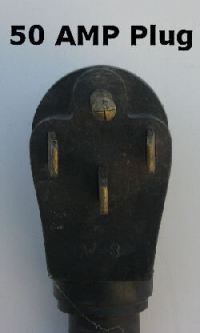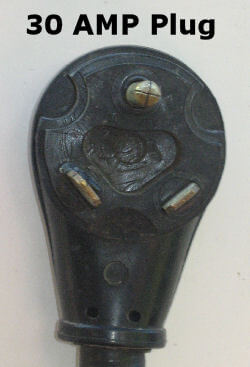- Home Page
- Ask RV Questions
- Can I Plug in A RV To a Home Electrical System?
Can I Plug in A RV To a Home Electrical System?
by Ronnette Adams
(Los Angeles, CA)

How to Plug Your RV Into a Home Electrical System
My sister has an RV pad at the side of her home behind a gated fence. I've been laid off from my job for the second time this year. To help me out, she said I can put a travel trailer on the pad to stay if I need to. Would I be able to plug into electricity at the house? Does a trailer and a regular home use the same voltage/amps (whatever?). I already figured out how to handle gray water, but I need to know about the electricity. Thank you.
ANSWER Hi Ronnette, I am so sorry that you are going through these circumstances right now, and I hope that you get back on your feet quickly.
Now to answer your question, yes, you can hook up the Travel Trailer to electric in the house but, you are going to be severely limited on what appliances can be run, and you will not be as comfortable as you could be if the Travel Trailer was hooked up to a proper source of electricity.
I would strongly suggest that you contact an Electrician and get an estimate on installing a 30- or 50-Amp receptacle close to the RV pad. This may be a better option.
Here are the steps to follow to set up the trailer to work on a 3-prong household plug.
Determine if the Travel Trailer is set up for 50 Amps or 30 Amps
If you have the owner’s manual for the travel trailer, it will tell you if you require 30 amp or 50-amp service. Either way, you can run some of the appliances (with limitations) off a 15- or 20-amp household 3-prong receptacle. If you do not have the manual, the easiest way to determine the setup is by looking at the male plug in the electrical compartment of the trailer.


Now that we know what setup you have, look below to find out what adapters you will need.
30 Amp Setup The setup is straightforward; all you need is a 30 Amp Female to 15 Amp Male Adapter. Either one of the adapters listed below will work.

Camco 55165 RV 12" PowerGrip Dogbone Electrical Adapter with Handle

Camco 55223 15M/30F AMP PowerGrip Adapter
50 Amp Setup You will need one of the 30-amp to 15-amp adapters listed above, and you will also need a 50 Amp Female to 30 Amp Male adapter. Either one of the 2 adapters listed below will work for you.

Camco 55185 RV 18" PowerGrip Dogbone Electrical Adapter with Handle

Dogbone Adapter with Handle, 30 Amp Male to 50 Amp Female
Now you would plug your RV into the 50 Amp to 30 Amp adapter and plug the other end of the adapter into the 30 Amp to 15 Amp Adapter and plug that adapter into your home electric.
Good Sam members enjoy instant discounts on fuel. Join Today!
The 3-prong receptacle in the house could either be on a 15- or 20-amp circuit. The way to find out is by looking at the circuit breaker box.
Also, understand that the circuit for the plug you are using may have other plugs on it as well. If the circuit you are using is a 15-amp circuit, it means that the total amps on that circuit cannot be greater than 15 amps, or the breaker will trip. So, you may not actually have 15 amps available to you depending on what else is operating off that circuit.
Plugging in the Trailer
Once you have installed the three-prong adapter on the power cord from the travel trailer, it is time to plug it in.
Special Note: If for some reason the power cord on the RV does not reach the receptacle you are going to plug into on the house, you may want to use an extension cord. If this is the case, it is important to understand that you cannot just use any extension cord that you buy at a hardware store.

The extension cord should be at least a 10 Gauge Vinyl Outdoor Extension Cord and should be just long enough to reach the receptacle you are plugging into. Using a longer extension cord can create more heat and also becomes more inefficient.
Here are the steps to take the first time you plug in.
1. Make sure all electrical appliances in the Travel Trailer are turned off.
2. Turn off the breaker on the house circuit you are using.
3. Plug the travel trailer electric cord into the house receptacle you have chosen.
4. Reset the house circuit breaker; you should now have electric to the Travel Trailer. If the circuit breaker goes off again, double-check to make sure that all electrical appliances in the Travel Trailer are turned off.
Limitations on Running Appliances
Just because you are now plugged in does not mean you can run all the electrical appliances at one time like you could if you were hooked up at a campground or RV park. You must limit your usage to be below the 15- or 20-Amp limit for the circuit you are hooked up to. If you exceed the amperage limit, you will continually trip the house circuit breaker.
Here are some Amp usage numbers for common electrical items found in an RV.
AMP HOGS
These appliances should not be run at the same time, or you will trip the circuit breaker.
Roof Air Conditioner, Hair Dryer, Microwave, Toaster or Toaster Oven.
OK To Run Together
These appliances can be run safely together, TV, VCR, Laptop Computer, and RV Refrigerator.
If you are not sure how many amps an appliance uses, here is a simple formula to determine amps.
Divide the Watts by the Volts, and that will give you the Amps for that appliance.
You can now see that this may not be the ideal way of using the Travel Trailer, but if you are only planning on using it for sleeping, it can be done.
Happy RVing
RVing Al
Comments for Can I Plug in A RV To a Home Electrical System?
|
||
|
||
|
||
|
||
|
||
|
||
|
||
|
||
|
||
|
||
|
||
|
||
|
||
|
||
|
||
|
||
|
||
|
||
|
||
|
||
|
||
|
||
|
||
|
||
|
||
|
||
|
||
|
||
|
||
|
||
|
||
|
||
|
||
|
||
|
||
|
||
|
||








